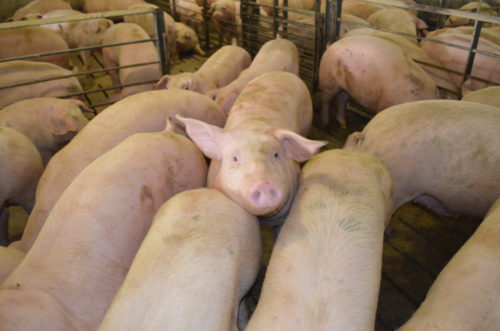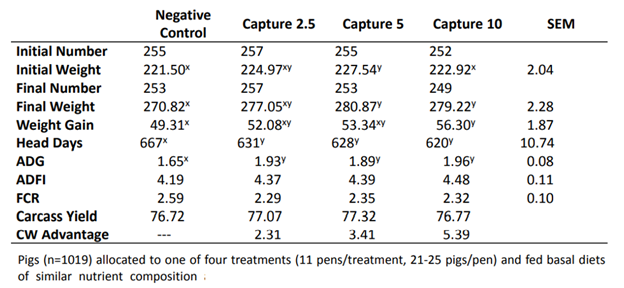Help Your Hogs Beat the Heat This Summer
Posted: June 2, 2021 | Written By: Dr. Mark Whitney, Swine Nutrition and Production Specialist

Swine producers face many challenges throughout the lifetime of raising a pig from conception, to birth, to market. Although many of the early stages receive the most attention, some of the most substantial impact to the bottom line can occur at the very end right before marketing animals. Limitations in pen space and feeder and water access, further impacted by greater market weights, ultimately drags growth performance during late stages of finishing, resulting in loss of potential profits. When animals are handled, moved, and transported to market, the additional stress often results in carcass shrink loss, increased downers, and DOAs.
The heat of summer exacerbates these challenges. When the effective environmental temperature exceeds 70 degrees F, the animal physiologically begins to make adjustments in order to cope with the heat stress. Voluntary feed intake is reduced as a way to minimize the amount of heat produced during digestion of feedstuffs. Blood flow is shunted away from organs, including the digestive system, and towards extremities to dissipate excess heat. As one would expect, nutrient digestion and absorption is reduced. The pig does not sweat appreciably, so the majority of heat dissipation occurs during respiration. This also draws out water from the animal, resulting in whole body and cellular dehydration. To make matters worse, today’s leaner genetics have resulted in pigs that generate more heat, thus providing more heat that needs to be removed. Ultimately heat stress results in more significant reductions in feed intake, conversion, and growth along with susceptibility to diseases and conditions such as leaky gut.
What can be done to minimize the impacts of heat stress? Increasing the space allowance and access to feeders and waters can help some, but have significant impacts on economics. Most producers will “top off” pens, removing the heaviest pigs out of each pen 2 – 4 weeks prior to the remaining pigs being marketed, providing additional space for remaining pigs without the negative economic impact. Taking all steps possible to improve environmental conditions are certainly key. Correct use and management of misters or sprinklers combined with fans and air movement can be very effective in reducing heat from pigs via evaporation. If improperly managed, however, pens can become messy and/or humidity levels can rise, resulting in further heat stress. A very common tool nutritionally is to remove excess fiber and increase fat levels in diets during the summer. The amount of heat produced to digest fat vs other energy sources is much less, resulting in less heat production by the animal. Additionally, combining increased amino acid digestibility along with the increased energy density coming from fat helps to at least partially offset the reduction in daily nutrient intake due to reduced feed intake from heat stress.
An additional tool that can be used effectively to minimize the impact of heat on late finishing pigs is the use of Capture, a heat abatement performance additive available through Form-A-Feed. This technology utilizes a combination of electrolytes, sugars, and other essential nutrients to replenish cellular hydration and maintain gut integrity. Fed at a level of 5 – 10 lbs/ton in late finishing the final 2 – 4 weeks prior to market, Capture has been proven to improve pig performance, especially during the hot summer months. Increases in feed intake and improved feed conversion, resulting in greater live weight gains and reduced shrink loss, ultimately correlates to greater carcass weights (see table).
In addition to animal performance improvements, Capture has also been demonstrated to reduce pig stress during handling and transportation. Numerous field studies and observations have shown an improvement in pig temperament and handling during load out, along with reduced animal injuries and DOAs during transport to market.
What is an additional 3 – 5.5 lb of carcass weight worth to you? Using a carcass price of $110/cwt, late finishing diet cost of $250/ton, and providing Capture ($1/lb) at 5 lb/ton the final 20 d before market, one would expect an increase of 5% in feed intake resulting in a minimum gain of 3.5 lb carcass weight. The cost of additional feed and Capture would be $1.06/pig, while the value of the added carcass weight would be $3.85/pig. Net return to the producer would be $2.79/pig, providing an ROI of 3.6. These calculations are conservative, and do not take into account any reduction in animal losses during transportation, which would also be expected. No additional changes to diet formulation or pig management are needed.
Are you interested in leaving an additional $2.50 – $3.00 per head on the table this summer, or would you rather put that money in your pocket? Contact your Form-A-Feed representative today and ask them to review Capture with you and calculate what your savings can be this summer while you help your hogs beat the heat!
